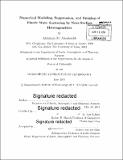| dc.contributor.advisor | M. Nafi Toksöz. | en_US |
| dc.contributor.author | Almuhaidib, Abdulaziz M | en_US |
| dc.contributor.other | Massachusetts Institute of Technology. Department of Earth, Atmospheric, and Planetary Sciences. | en_US |
| dc.date.accessioned | 2014-10-08T15:22:21Z | |
| dc.date.available | 2014-10-08T15:22:21Z | |
| dc.date.copyright | 2014 | en_US |
| dc.date.issued | 2014 | en_US |
| dc.identifier.uri | http://hdl.handle.net/1721.1/90680 | |
| dc.description | Thesis: Ph. D., Massachusetts Institute of Technology, Department of Earth, Atmospheric, and Planetary Sciences, 2014. | en_US |
| dc.description | Cataloged from PDF version of thesis. | en_US |
| dc.description | Includes bibliographical references. | en_US |
| dc.description.abstract | In arid environments, near-surface complexity and surface topography present major challenges to land seismic data acquisition and processing. These challenges can severely affect data quality and introduce uncertainty into reservoir imaging and characterization. The primary objectives of this thesis are to model and study the contribution of near-surface heterogeneities on seismic wavefield scattering for better understanding of land seismic data, develop an effective approach to filter out the scattered noise from the seismic records to enhance the signal-to-noise ratio, and to accurately image and locate the near-surface heterogeneities. The first part of this thesis is concerned with simulating the effects of seismic wave scattering from buried, shallow, subsurface heterogeneities through finite difference numerical forward modeling. The near-surface scattered wavefield is modeled by separating the incident (i.e., in the absence of scatterers) from the total wavefield by means of a perturbation method. Wave propagation is simulated for several earth models with different near-surface characteristics to isolate and quantify the influence of scattering on the quality of the seismic signal. We show that the scattered field is equivalent to the radiation field of an equivalent elastic source excited at the scatterer locations. Moreover, the scattered waves consist mostly of body waves scattered to surface waves and are, generally, as large as, or larger than, the reflections. These scattered waves often obscure weak primary reflections and can severely degrade the image quality. The results indicate that the scattered energy depends strongly on the properties of the shallow scatterers and increases with increasing impedance contrast, increasing sizes of the scatterers, decreasing depth of the scatterers, and increasing the attenuation factor of the background medium. Also, sources deployed at depth generate weak surface waves, whereas deep receivers record weak scattered surface waves. The analysis and quantified results help in the understanding of the scattering mechanisms and, therefore, can lead to developing new acquisition and processing techniques to reduce the scattered surface waves and enhance the quality of the seismic image. The second part of this thesis develops an approach based on spatially varying local-slope estimation, aiming at alleviating the effects of scattered surface waves and enhancing the quality of the seismic signal. Understanding the mechanism and behavior of the simulated scattered surface waves in the first part of this thesis form the basis for designing the filtering scheme. The algorithm is based on predicting the spatially varying slope of the noise, using steerable filters, and separating the signal and noise components by applying a directional non-linear filter oriented toward the noise direction to predict the noise and then subtract it from the data. The slope estimation step using steerable filters is very efficient, as it requires only a linear combination of a set of basis filters at fixed orientation to synthesize an image filtered at an arbitrary orientation. We apply our filtering approach to simulated data as well as to seismic data recorded in the field to suppress the scattered surface waves from reflected body-waves, and demonstrate its superiority over conventional f - k techniques in signal preservation and noise suppression. The third part of this thesis presents an approach for prestack elastic reverse time migration (RTM) to locate and image near-surface heterogeneities using the near-surface scattered waves (e.g., body to P, S, and surface waves). The approach back-projects the scattered waves until they are in phase with the incident waves at the scatterer locations. The P wave components (divergence of the wavefield) are derived from the spatial derivatives of the measured wavefields. Imaging the near-surface heterogeneities is important for planning seismic surveys or explaining nearsurface related anomalies in the data. The scattered body-to-surface waves travel horizontally along the free surface, and, therefore, they provide optimal illumination of the near-surface compared to scattered body-to-body waves. Additionally, the elastic RTM scheme preserves the relative amplitude because all wave propagation losses, including mode conversions, are properly taken into account. We demonstrate, using synthetic data, that elastic RTM of near-surface scattered waves constructs an accurate and reliable depth image of near-surface scatterers. | en_US |
| dc.description.statementofresponsibility | by Abdulaziz M. Almuhaidib. | en_US |
| dc.format.extent | 173 pages | en_US |
| dc.language.iso | eng | en_US |
| dc.publisher | Massachusetts Institute of Technology | en_US |
| dc.rights | M.I.T. theses are protected by copyright. They may be viewed from this source for any purpose, but reproduction or distribution in any format is prohibited without written permission. See provided URL for inquiries about permission. | en_US |
| dc.rights.uri | http://dspace.mit.edu/handle/1721.1/7582 | en_US |
| dc.subject | Earth, Atmospheric, and Planetary Sciences. | en_US |
| dc.title | Numerical modeling, suppression, and imaging of elastic wave scattering by near-surface heterogeneities | en_US |
| dc.type | Thesis | en_US |
| dc.description.degree | Ph. D. | en_US |
| dc.contributor.department | Massachusetts Institute of Technology. Department of Earth, Atmospheric, and Planetary Sciences | |
| dc.identifier.oclc | 890657777 | en_US |
